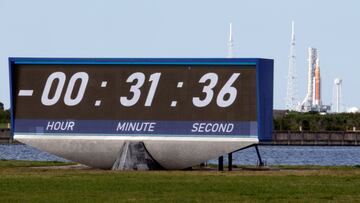NASA
When will NASA’s Artemis I launch and what is its mission?
NASA is gearing up for the first flight of its Artemis programme, which aims to return humans to the surface of the Moon for the first time in half a century.

Artemis I, a three-week mission to the Moon that will test out a trio of key systems in NASA’s Artemis programme, is due for launch “not before May 2022″, the space agency says. The uncrewed flight will test the Orion spacecraft, the Space Launch System (SLS) rocket and the ground systems at Kennedy Space Center in Cape Canaveral, Florida.
Watch the Artemis I launch live
Artemis seeks to end 50-year wait to return to Moon
Initiated in 2017, the Artemis programme aims to return humans to the Moon for the first time since the Apollo 17 mission in 1972, before establishing a base camp on the surface and a mini-space station in lunar orbit, allowing for longer-duration stays on the Earth’s satellite. Artemis also seeks to lay the foundations for future crewed missions to Mars.
Artemis’ initial aim was to land humans on the Moon in 2024, but NASA Administrator Bill Nelson said in November that this objective won’t be met. “2024 was not a goal that was really technically feasible,” Nelson told reporters. “We are estimating no earlier than 2025.”
‘Wet dress rehearsal’ before Artemis I mission
Ahead of the launch of Artemis I, NASA must first complete a crucial testing stage known as the ‘wet dress rehearsal’, which is a walk-through of all launch-day procedures. It is known as a ‘wet’ rehearsal because this process includes fuelling the SLS rocket. “Wet dress rehearsal testing is slated to resume with call to stations on Tuesday, April 12 and tanking on Thursday, April 14,” a NASA update released on Saturday said.
On launch day, Artemis I will take off from Launch Complex 39B at Kennedy Space Center, the SLS rocket generating some 8.8 million pounds of thrust during liftoff. The SLS will carry the Orion into Earth orbit, before the rocket’s core stage separates from the spacecraft. The SLS’ interim cryogenic propulsion stage will then produce the thrust required to take the Orion out of Earth orbit and towards the Moon.
Once the Orion reaches the Moon, it will come to within 62 miles of the lunar surface, before settling into an orbit at an altitude of about 40,000 miles. After six days in lunar orbit, it will begin its journey back to Earth, where the final stage of the mission will test the craft’s ability to complete a safe return home. After re-entering the Earth’s atmosphere - its heat shield enduring temperatures of around 5,000ºF, roughly half as hot as the Sun - the Orion is due to splash down close to a US Navy recovery ship off the coast of Baja, California.
“This is a mission that truly will do what hasn’t been done and learn what isn’t known,” says Artemis Mission Manager Mike Sarafin. Orion will remain in space for a longer period than any other craft for astronauts has managed without docking to a space station, and will “return home faster and hotter than ever before”, NASA says.
Artemis III to be first crewed Moon landing flight
As part of Artemis, NASA has pledged to land the first woman and the first person of colour on the Moon, with Artemis III slated as the programme’s first crewed Moon landing mission. Early Artemis flights will involve short stays on the Moon, the crew transferring directly from the Orion to a lunar-landing vehicle that will take them to the surface. After arrival on the Moon, the lander will double up as their base.
Once the mini-space station (known as the ‘gateway’) is built, astronauts will transfer to the lander via this staging point, and as the base camp begins to take shape - it is to be constructed near the Moon’s south pole - the facility will take over from the lander as the crew’s lunar habitat. The base camp is also set to include a lunar rover and a mobile home.
The plan is for Artemis missions to grow in length to up to two months. “On each new trip, astronauts are going to have an increasing level of comfort with the capabilities to explore and study more of the Moon than ever before,” Kathy Lueders, NASA’s associate administrator for human spaceflight, says.
“With more demand for access to the Moon, we are developing the technologies to achieve an unprecedented human and robotic presence 240,000 miles from home. Our experience on the Moon this decade will prepare us for an even greater adventure in the universe - human exploration of Mars.”






